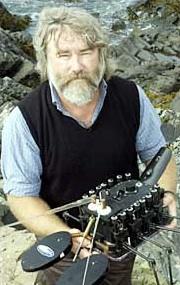Programme
- Conference day 1 : Wednesday 31st August
- Conference day 2 : Thursday 1st September
- Industry-Academia Day : Friday 2nd September
The conference venue address is Sheffield Hallam University, Furnival Building, City Campus, 153 Arundel Street, Sheffield, S1 2NU, UK
All lectures are in room 9130 of the Furnival Building. Registration opens at 07:30 on Wednesday, 31/08/2011.
Wednesday - 31st August 
09:00 - 09:10 Welcome
Welcome by Prof. Mike Smith (pro Vice Chancellor for Research at Sheffield Hallam University)09:10 - 10:00 Plenary Session
BioMimetic robots may be used to develop new technologies inspired from the existence proofs of solution to a given problem provided by studies of animal behavior. Conversely BioMimetic robots can be used as analytical tools to explore the neural and behavioral mechanisms by which animals meet the challenges of their natural environments. Most Bio-Roboticists contribute in both ways; advancing new technological concepts and illuminating the mechanisms of animal behavior from which they draw inspiration. This talk will emphasize the latter; the ways in which BioMimetic robots (or Bio-Robots) may contribute to our developing understanding of the neural systems that control behaviors in whole organisms. The sea abounds with invertebrate animals with body plans and neural architectures that contrast those of humans and indeed vertebrates in profound ways. Yet, these alien bodies and “simple” brains enable marine invertebrates to solve many of the same problems solved by higher vertebrates. The talk will highlight the abundant, challenging and novel opportunities for BioMimetic inquiry with advanced marine invertebrates. I will present examples of parallel behavioral and robotic (or simulation) studies in crustaceans (“crunchies”) and cephalopods (“squishies”) conducted with students in my laboratory and collaborators in other laboratories. The talk will illustrate the specific utility of BioMimetic robotics inspired by advanced marine invertebrates for understanding basic mechanisms of brain, body and behavior.
10:00 - 10:40 Paper Session 1
10:00 - 10:20 Mapping with sparse local sensors and strong hierarchical priors. Charles W. Fox and Tony J. Prescott
10:20 - 10:40 A Recursive Least Squares Solution for Recovering Robust Planar Homographies. Saad Ali Imran and Nabil Aouf
10:40 - 11:00 Coffee Break
11:00 - 12:00 Paper Session 2
11:00 - 11:20 Sensing with artificial tactile sensors: An investigation of spatio-temporal inference. Asma Motiwala, Charles Fox, Nathan F. Lepora and Tony J. Prescott
11:20 - 11:40 A cricket-controlled robot orienting towards a sound source. Jan Wessnitzer, Alexandros Asthenidis, Georgios Petrou, and Barbara Webb
11:40 - 12:00 Deformation-based tactile feedback using a biologically-inspired sensor and a modified display. Calum Roke, Chris Melhuish, Tony Pipe, David Drury and Craig Chorley
12:00 - 13:10 Lunch Break
13:10 - 14:10 Paper Session 3
13:10 - 13:30 Design and Control of an Upper Limb Exoskeleton Robot RehabRoby. Fatih Ozkul, Duygun Erol Barkana
13:30 - 13:50 Real-World Reinforcement Learning for Autonomous Humanoid Robot Charging in a Home Environment. Nicolas Navarro, Cornelius Weber, and Stefan Wermter
13:50 - 14:10 A Task Space Integral Sliding Mode Controller Implementation for 4DOF of a Humanoid BERT II arm with Posture Control. Said Ghani Khan, Jamaludin Jalani, Guido Herrmann, Tony Pipe, and Chris Melhuish
14:10 - 15:10 Poster Teaser 1
15:10 - 15:30 Tea Break
15:30 - 16:20 Manned Poster Session 1
16:20 - 17:40 Paper Session 4
16:20 - 16:40 Contextual Recognition of Robot Emotions. Jiaming Zhang and Amanda J.C. Sharkey
16:40 - 17:00 An Eye Detection and Localization System for Natural Human and Robot Interaction without Face Detection. Xinguo Yu, Weicheng Han, Liyuan Li, Ji Yu Shi and Gang Wang
17:00 - 17:20 Towards Safe Human-Robot Interaction. Elena Corina Grigore, Kerstin Eder, Alexander Lenz, Sergey Skachek, Anthony G. Pipe, Chris Melhuish
17:20 - 17:40 What can a Personal Robot do for you? Guido Bugmann and Simon. N. Copleston
19:30 Pre Dinner drinks, Millenium Gallery
20:00 Conference Dinner, Millenium Gallery
Thursday - 1st September

09:10 - 10:00 Plenary Session
Robots are now getting good at knowing where they are - I will discuss how this has come to pass, what the state of the art is and where the field is heading now. I will highlight some of the work that the Oxford Mobile Robotics Group has undertaken over the past few years with a particular emphasis on exploiting vision and laser sensors to navigate, map and interpret workspaces. Our research interests lie squarely in the domain of vast scale persistent navigation and mapping and accordingly I will illustrate our systems and algorithms working over city and county scales.
10:00 - 10:40 Paper Session 5
10:00 - 10:20 Robot Routing Approaches for Convoy Merging Maneuvers. Fernando Valdes, Roberto Iglesias, Felipe Espinosa, Miguel A. Rodriguez, Pablo Quintia and Carlos Santos
10:20 - 10:40 Walking Rover Trafficability - Presenting a Comprehensive Analysis and Prediction Tool. Brian Yeomans and Chakravathini M. Saaj
10:40 - 11:00 Coffee Break
11:00 - 12:00 Paper Session 6
11:00 - 11:20 Evaluating the effect of robot group size on relative localisation precision. Frank E. Schneider and Dennis Wildermuth
11:20 - 11:40 Towards Temporal Verification of Emergent Behaviours in Swarm Robotic Systems. Clare Dixon, Alan Winfield, and Michael Fisher
11:40 - 12:00 Costs and benefits of behavioral specialization. Arne Brutschy, Nam-Luc Tran, Nadir Baiboun, Marco Frison,
Giovanni Pini, Andrea Roli, Marco Dorigo, and Mauro Birattari
12:00 - 13:10 Lunch Break
13:10 - 14:00 Plenary Session
Robots are increasingly establishing their credibility as useful assistants outside traditional industrial environments, with new challenges emerging for intelligent robotics research. To personalise the interaction with human users, robots need to develop life-long user models that can be used to recognise human actions, predict human intentions and assist intelligently, while constantly adapting to changing human profiles. In this talk, I will draw inspiration from biological systems and describe our latest advances in embodied social cognition mechanisms for humanoid robots, and describe their application towards adaptive robotic assistants for children and adults with disabilities.
14:00 - 15:00 Poster Teaser 2
15:00 - 15:20 Tea Break
15:20 - 16:10 Manned Poster Session 2
16:10 - 17:10 Paper Session 7
16:10 - 16:30 Short-range Radar Perception in Outdoor Environments. Giulio Reina, James Underwood, and Graham Brooker
16:30 - 16:50 Supervised Traversability Learning for Robot Navigation. Ioannis Kostavelis, Lazaros Nalpantidis, and Antonios Gasteratos
16:50 - 17:10 Locomotion Selection and Mechanical Design for a Mobile Intra-abdominal Adhesion-reliant Robot for Minimally Invasive Surgery. Alfonso Montellano Lopez, Mojtaba Khazravi, Robert Richardson, Abbas Dehghani, Rupesh Roshan, Tomasz Liskiewicz, Ardian Morina, David G. Jayne, Anne Neville
17:10 - 17:40 Awards
Prof. Chris Melhuish17:40 - 18:00 Announcement FIRA-TAROS 2012
Prof. Tony Pipe (University of The West of England, Bristol)18:00 - 18:20 Launch SCentRO
Sheffield Centre for Robotics
by Professor Mike Smith (pro Vice Chancellor, Sheffield Hallam University) and Prof. Richard Jones (pro Vice Chancellor, The University of Sheffield)followed by Reception
18:20 - 19:00 Reception
drink and snacks will be offered Industry-Academia Day

09:00 - 10:00 Plenary Session
Developed agriculture always needs to find new ways to improve efficiency. One approach is to utilise available information technologies in the form of more intelligent machines to reduce and target energy inputs in more effective ways than in the past. Precision Farming has shown benefits of this approach but we can now move towards a new generation of equipment. The advent of autonomous system architectures gives us the opportunity to develop a complete new range of agricultural equipment based on small smart machines that can do the right thing, in the right place, at the right time in the right way.
10:00 - 12:00 Exhibition / Demonstrations
12:00 - 13:15 Lunch Break
Parallel event:
Launch of the Academic Forum for Robotics
(C. Buxton, BARA)
13:15 - 13:20 Panel Opening
13:20 - 14:40 Panel Topics
Libor Kral (EU Unit 5 Cognitive Systems and Robotics)
BARA
Tony Prescott (University of Sheffield, UK)
Geoff Pegman (Electronics KTN)
Daniel Jones
14:45 - 15:10 Panel discussion
Chair: Chris Melhuish, (Bristol Robotics Lab)
15:30 - 17:00 Exhibition and Demonstrations
Public Access.
17:00 - 17:30 Registration and Refreshments
17:30 - 18:30 Public Lecture: The Ethical Roboticist
Public Access. Organised by the Institution of Engineering and Technology
The Ethical Roboticist by Professor Alan Winfield
"Where is robotics going?" is a question that receives a great deal of attention. The reason for this owes much to the fictional roots of robotics and the fact that robots have a significant place in our cultural imagination. Thus roboticists find themselves having to address fears and fascinations that often have little to do with the reality of robotics. This lecture will address the question of robotic futures by - as far as possible - unpicking the fantastical and the plausible. Like any transformative technology, intelligent robotics has the potential for huge benefit, but is not without risk. Seventy years ago Asimov created his fictional laws of robotics. I believe it is now time for a revision but, as I will argue in this lecture, it makes no sense to talk about how present-day or near-future robots can be ethical. I will, however, outline the case for a new ethical code for roboticists.Plenary Speaker

Joseph Ayers was regretably unable to give the scheduled talk due to unforseen circumstances. The plenary talk was given by
Frank W. Grasso
Plenary Speaker

Paul Newman obtained an M.Eng. in Engineering Science from Oxford University in 1995. He then undertook a Ph.D. in autonomous navigation at the Australian Center for Field Robotics, University of Sydney. In 1999 he returned to the United Kingdom to work in the commercial sub-sea navigation industry. In late 2000 he joined the Dept of Ocean Engineering at M.I.T. where as a post-doc and later a research scientist, he worked on algorithms and software for robust autonomous navigation for both land and sub-sea agents. In early 2003 he returned to Oxford as a Departmental Lecturer in Engineering Science before being appointed to a University Lectureship in Information Engineering and becoming a Fellow of New College in 2005. He heads the Oxford Mobile robotics Research group and has research interests in pretty much anything to do with autonomous navigation but particularly Simultaneous Localisation and Mapping.
Plenary Speaker

Yiannis Demiris heads the Bioinspired Assistive Robots and Teams (BioART) laboratory at the Department of Electrical and Electronic Engineering of Imperial College London, doing research on human-robot interaction, assistive robotics, and multirobot teams, with an emphasis on the mechanisms of development and learning. He received his PhD in Intelligent Robotics from the Department of Artificial Intelligence of the University of Edinburgh in 1999, and joined the faculty of Imperial College in 2001. He has organised several international conferences, including the IEEE conference on Development and Learning (ICDL-2007) as chair and the ACM/IEEE conference on Human Robot Interaction (HRI-2008) as program chair. He has edited three books on robot learning and guest edited special journal issues of the IEEE Transactions on Systems, Man and Cybernetics (Part-B) on Robot Learning by Demonstration and Imitation, and the journal of Adaptive Behaviour on developmental robotics. He has received fellowships from the European Science Foundation and AIST in Japan, and is a member of EPSRC college, and a senior member of the IEEE. He is participating in two European FP7 projects, ALIZ-E (Adaptive Strategies for Sustainable Long-Term interaction) and EFAA (Experimental Functional Android Assistant), while collaborating in industrial research projects with BAE Systems, and IBM.
Plenary Speaker

Simon Blackmore is a discipline leader in Precision Farming and agricultural robotics with a world-wide reputation. He has worked in Greece, Denmark, the UK and has spent 6 years working in Africa. Simon is the managing director of his own company called Unibots Ltd that is commercialising academic research in mobile outdoor robots. Simon holds visiting Chairs at the University of Thessaly in Greece, Bristol Robotics Lab in UK, China Agric University, Beijing and Tokyo University of Agriculture and Technology in Japan and regularly gives keynote presentations around the world on robotic agriculture. Currently he is the manager of the EU "Farm of Tomorrow" project called FutureFarm. Simon latest project is setting up the European Agricultural Robotics Network.
Plenary Speaker

Prof. Alan Winfield Alan Winfield is Hewlett-Packard Professor of Electronic Engineering and Director of the Science Communication Unit at the University of the West of England, Bristol. He conducts research in swarm robotics in the Bristol Robotics Laboratory and is especially interested in robots as working models of life, evolution, intelligence and culture. Alan is passionate about communicating science and technology. He holds an EPSRC Senior Media Fellowship with the theme Intelligent Robots in Science and Society, and blogs about robots, open science and related topics.




